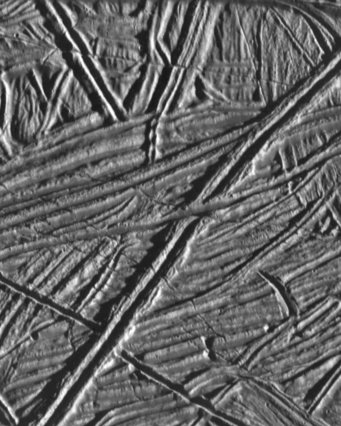The heat pump in Europa's ocean
Researchers model currents beneath the frozen surface of Jupiter’s moon

Furrowed terrain: the outer icy shell of Jupiter’s moon Europa has a delicate network of large and small cracks. The image was taken by the Galileo space probe.
At least as fascinating as the strikingly rugged ice sheet of Jupiter’s moon Europa is what is hidden underneath: a subsurface saltwater ocean kept free of ice by tidal forces and the heat stored in the interior of the celestial body. As far back as 1998, measurements recorded by the magnetometer on board NASA’s Galileo space probe suggested the existence of these almost inaccessible water masses. Many of their properties still remain a mystery, however, for example, whether conditions exist there which could be conducive to the formation of life.
The new model computations by the team from the University of Texas and the Max Planck Institute for Solar System Research now allow scientists to take a look under the icy blanket. Their simulations disclose the currents in the ocean: “The motions in Europa’s ocean are driven by temperature gradients,” says Max Planck researcher Johannes Wicht. Water that is warmer and therefore lighter rises to the top, colder water sinks to the bottom.
Scientists call this motion convection – the same principle as we see when boiling a pan of water on the hob. Convection transports heat from the depths of the ocean to the outside. “Our computer simulations show that convection in the equatorial region is stronger than at the poles. The water at lower latitudes is therefore warmer and the ice cover is heated more effectively,” is how Wicht summarises the new results.

Whether and how exactly this heat causes the cracks in the layer of ice has not yet been ascertained for certain. It may be that the higher temperature is not the only factor. The ice heated from below also has a lower salinity. “These two facts mean that this ice is lighter than the layer above it and so it pushes its way to the surface,” says Wicht. The movements in the ice are probably what cause the cracks and fissures.
In their computations, the researchers take into account the fact that two effects essentially determine the type of water currents in the subsurface ocean: warmer water rises up from the interior of the moon, and its rotation also has an effect: the Coriolis force diverts these currents. “How exactly the water flows depends on the interplay between these two effects,” says Wicht. The Coriolis force seems to have less of an effect in Europa’s ocean than previously assumed. “This is why our new computer models differ significantly from their predecessors.”
In addition to the water currents in the radial direction, the researchers also found three pronounced currents which flow largely parallel to the ice sheets in a westerly or easterly direction: at the equator, the water flows westwards and in the polar regions it flows eastwards. “On Earth, there are similar permanent currents in the ocean – the Gulf Stream, for example,” says Johannes Wicht. Known as jet streams, whether they also affect the layer of ice above them is not clear.
BK / HOR

